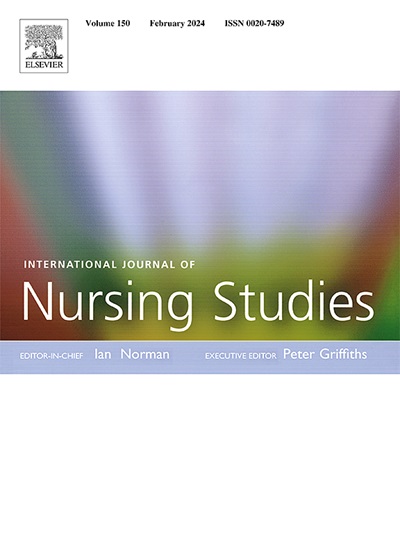Risk prediction model for chemotherapy-induced nausea and vomiting in cancer patients: a systematic review
IF 7.1
1区 医学
Q1 NURSING
引用次数: 0
Abstract
Background
Chemotherapy-induced nausea and vomiting increase the healthcare burden and lead to adverse clinical outcomes in cancer patients. Although many risk prediction models for chemotherapy-induced nausea and vomiting have been developed, their methodological quality and applicability remain uncertain.
Objectives
To systematically review and evaluate existing studies on risk prediction models for chemotherapy-induced nausea and vomiting in cancer patients.
Methods
PubMed, the Cochrane Library, Embase, Web of science, CINAHL, Scopus, China National Knowledge Infrastructure (CNKI), China Science and Technology Journal Database (VIP), Wanfang Database, Chinese Biomedical literature Database (CBM) were systematically searched from inception to October 1, 2024. Studies were appraised critically and data extracted by two authors independently based on the Prediction Model Risk of Bias Assessment Tool (PROBAST) and Data Extraction for Systematic Reviews of Prediction Modeling Studies (CHARMS).
Results
A total of 4195 articles were retrieved, ultimately including 17 studies with 62 models for chemotherapy-induced nausea and vomiting. The sample size of the included studies ranged from 137 to 2215, with areas under the curve ranging from 0.602 to 0.850. In this study, the deep forest model demonstrated strong discrimination and calibration, outperforming conventional machine learning and traditional regression models. The five most important predictors in the deep forest model were creatinine clearance, age, sex, anticipatory nausea and vomiting, and antiemetic regimen. Across all included studies, age, chemotherapy regimens, cycles of chemotherapy, history of alcohol consumption, prior episodes of chemotherapy-induced nausea and vomiting, sleep quality before chemotherapy, sex, antiemetic regimens, history of morning sickness, anticipatory nausea and vomiting, were the most frequently reported predictors. All studies were rated as high risk of bias mainly due to poor reporting of the participants and analysis domains, with high concerns regarding applicability in 9 studies.
Conclusion
The research on prediction models for chemotherapy-induced nausea and vomiting model is in its developing stage, with both commonalities and differences in predictors. Despite the overall acceptable performance of chemotherapy-induced nausea and vomiting models, most studies have methodological shortcomings, and few models have been validated. Future studies should refer to the Transparent Reporting of a Multivariable Prediction Model for Individual Prognosis or Diagnosis (TRIPOD) guideline for model design, implementation, and reporting. Moreover, studies with larger sample sizes and multicenter external validation are necessary to enhance the robustness of predictive models.
Registration
The protocol for this study is registered with PROSPERO (registration number: CRD42024505012).
癌症患者化疗引起的恶心和呕吐的风险预测模型:一项系统综述
背景:化疗引起的恶心和呕吐增加了癌症患者的医疗负担,并导致不良的临床结果。虽然已经建立了许多化疗引起的恶心和呕吐的风险预测模型,但它们的方法质量和适用性仍然不确定。目的系统回顾和评价癌症患者化疗致恶心呕吐风险预测模型的现有研究。方法系统检索spubmed、Cochrane Library、Embase、Web of science、CINAHL、Scopus、中国知网(CNKI)、中国科技期刊库(VIP)、万方数据库、中国生物医学文献库(CBM)自建库至2024年10月1日的数据库。基于预测模型偏倚风险评估工具(PROBAST)和预测建模研究系统评价数据提取(CHARMS),两位作者对研究进行了严格的评估和数据提取。结果共检索到4195篇文献,包括17项研究,62种化疗引起的恶心和呕吐模型。纳入研究的样本量范围为137 ~ 2215,曲线下面积范围为0.602 ~ 0.850。在本研究中,深度森林模型表现出较强的识别和校准能力,优于传统的机器学习和传统回归模型。在深森林模型中,五个最重要的预测因子是肌酐清除率、年龄、性别、预期恶心和呕吐以及止吐方案。在所有纳入的研究中,年龄、化疗方案、化疗周期、饮酒史、化疗引起的恶心和呕吐、化疗前的睡眠质量、性别、止吐方案、晨吐史、预期恶心和呕吐是最常见的预测因素。所有研究均被评为高偏倚风险,主要原因是参与者和分析领域的报告不佳,其中9项研究的适用性受到高度关注。结论化疗引起的恶心呕吐模型预测模型的研究尚处于发展阶段,预测因子既有共性也有差异性。尽管化疗引起的恶心和呕吐模型的总体表现是可以接受的,但大多数研究都存在方法学上的缺陷,并且很少有模型得到验证。未来的研究应参考《透明报告个体预后或诊断的多变量预测模型》(TRIPOD)指南进行模型设计、实施和报告。此外,需要更大样本量的研究和多中心的外部验证来增强预测模型的稳健性。本研究的方案已在PROSPERO注册(注册号:CRD42024505012)。
本文章由计算机程序翻译,如有差异,请以英文原文为准。
求助全文
约1分钟内获得全文
求助全文
来源期刊
CiteScore
15.00
自引率
2.50%
发文量
181
审稿时长
21 days
期刊介绍:
The International Journal of Nursing Studies (IJNS) is a highly respected journal that has been publishing original peer-reviewed articles since 1963. It provides a forum for original research and scholarship about health care delivery, organisation, management, workforce, policy, and research methods relevant to nursing, midwifery, and other health related professions. The journal aims to support evidence informed policy and practice by publishing research, systematic and other scholarly reviews, critical discussion, and commentary of the highest standard. The IJNS is indexed in major databases including PubMed, Medline, Thomson Reuters - Science Citation Index, Scopus, Thomson Reuters - Social Science Citation Index, CINAHL, and the BNI (British Nursing Index).

 求助内容:
求助内容: 应助结果提醒方式:
应助结果提醒方式:


